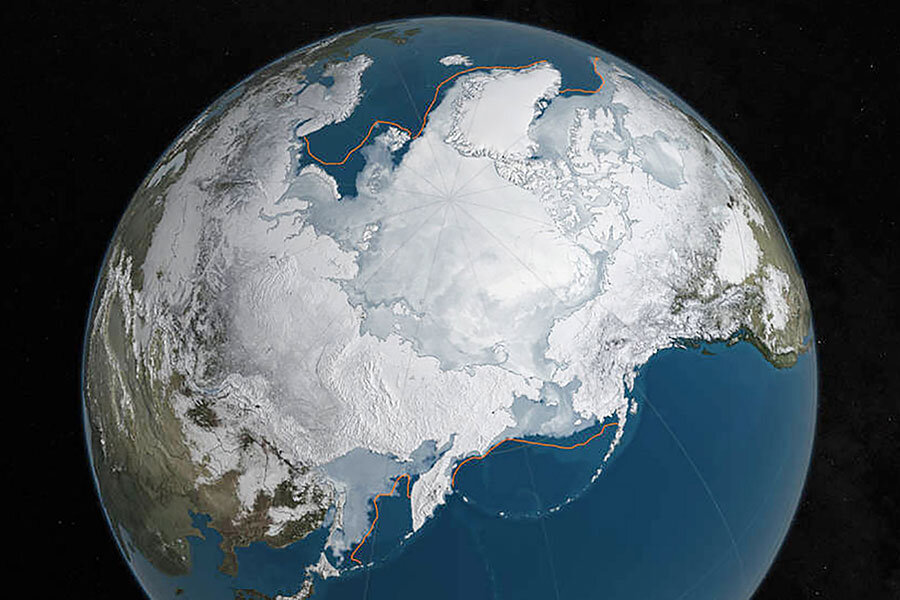As temperatures set a high record, Arctic sea ice sets a low one
Loading...
The National Snow and Ice Data Center and NASA released disturbing information on the state of Arctic sea ice growth on Monday. According to scientists at the NSIDC, this winter’s Arctic ice sheet fell five thousand square miles short of 2015 Arctic ice coverage, which hit record lows when it was announced last year.
This year’s Arctic ice coverage measured 5.607 million square miles total, about 413,000 square miles less than the 30-year average. Scientists at the NSIDC attribute this year’s sluggish growth to extremely warm temperatures, among other factors.
“I’ve never seen such a warm, crazy winter in the Arctic,” said NSIDC director Mark Serreze in a press release.
Researchers at NSIDC found that air temperatures over the Arctic varied between 4 to 11 degrees Fahrenheit above the average winter temperature. Although ice growth fluctuates from year to year, comments like Dr. Serreze’s indicate that this winter’s warmth was unprecedented.
“We also saw winds that impeded the ice growth,” Walt Meier, a NASA scientist who is also an NSIDC research affiliate, told The Christian Science Monitor in a phone interview. He explained that warmer winds from the south blew brought warm water and air to the edge of the ice sheet, creating conditions unfavorable to ice growth.
The result of the Arctic’s unseasonably warm weather was a smaller than usual ice sheet across the Arctic, except in a few areas such as the Labrador Sea and Hudson Bay.
The Barents Sea saw especially limited ice growth, prompting further study from scientists studying the effects of the Atlantic Meridional Overturning Circulation (AMOC) on sea ice growth.
“Some studies suggest that decreased heat flux of warm Atlantic waters could lead to a recovery of all Arctic sea ice in the near future,” said NSIDC scientist Julienne Stroeve in a press release. “I think it will have more of a winter impact and could lead to a temporary recovery of winter ice extent in the Barents and Kara seas.”
Others are more pessimistic about the future of the Arctic ice sheet as a whole, which first drew international notice when it hit a record low in 2005.
“The Arctic is in crisis,” said NSIDC lead scientists Ted Scampos. “Year by year, it’s slipping into a new state, and it’s hard to see how that won’t have an effect on weather throughout the Northern Hemisphere.”
Although sea ice experiences variation from year to year, Dr. Meier says, that the data shows a “very clear downward trend” in sea ice growth. Over the last 38 years of observations, the Arctic ice sheet has lost more than two Texases worth of sea ice.
According to Meier, sea ice loss very clearly equates to habitat loss for ice-dependent creatures, like polar bears and Arctic terns. Warm water temperatures could also impact fisheries.
And these record warm temperatures don’t just impact local species.
The shrinking blanket of sea ice will expose more of the Arctic ocean to evaporation, leading to even quicker warming and adding moisture to the atmosphere.
Meier told the Monitor that these changes could very well lead to fluctuations in worldwide weather patterns.
“What happens in the Arctic doesn’t stay in the Arctic,” he says.
Richard Primack, a climate scientist at Boston University, tells the Monitor that the warming trends scientists are following in the Arctic are already in evidence in our neighborhoods.
“This is a very dramatic example of climate change,” says Dr. Primack in a phone interview, “but it is a manifestation of the same phenomenon that is affecting us.”
According to Primack, the Northeast United States experienced springlike conditions this year in December. When Primack went for a walk on Christmas day, for example, he spotted flowering plants such as dandelions. Others told him that they had seen frogs on their holiday rambles.
Just like many Arctic species, many local plant species are not equipped to handle these enormous temperature fluctuations, he explains. Warming temperatures could have dangerous impacts both at home and in the far north.
“The Arctic is a very sensitive part of the climate system,” said Meier. “What is happening in the Arctic now is very likely an indicator of things to come for the rest of the globe.”








